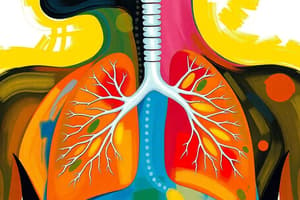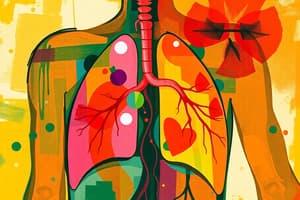Podcast
Questions and Answers
What is a common characteristic of organisms that breathe through their skin?
What is a common characteristic of organisms that breathe through their skin?
- They often live in dry environments to limit moisture loss.
- They are typically large and bulky organisms.
- They have small or flat bodies to maximize respiratory surface area. (correct)
- They have a high body volume compared to their respiratory surface.
What is a disadvantage of gas exchange in terrestrial animals compared to aquatic animals?
What is a disadvantage of gas exchange in terrestrial animals compared to aquatic animals?
- They face lower oxygen concentration gradients compared to water.
- They do not possess internal respiratory systems.
- They require constant movement to maximize oxygen intake.
- They have a higher risk of losing moisture due to their respiratory structure. (correct)
Which system is specifically mentioned as being common in insects for gas exchange?
Which system is specifically mentioned as being common in insects for gas exchange?
- Skin respiration
- Lungs
- Gills
- Tracheal system (correct)
What is the primary function of gills in aquatic animals?
What is the primary function of gills in aquatic animals?
How do Madagascar hissing cockroaches primarily use spiracles?
How do Madagascar hissing cockroaches primarily use spiracles?
What is primarily needed for cellular respiration?
What is primarily needed for cellular respiration?
Which phase is NOT part of gas transfer in animals with lungs?
Which phase is NOT part of gas transfer in animals with lungs?
Why do living organisms need to expel carbon dioxide?
Why do living organisms need to expel carbon dioxide?
What characteristic must respiratory surfaces have to ensure efficient gas diffusion?
What characteristic must respiratory surfaces have to ensure efficient gas diffusion?
What is the role of diffusion in the respiratory system?
What is the role of diffusion in the respiratory system?
In humans, what is the average breathing rate?
In humans, what is the average breathing rate?
Why is the right lung larger than the left lung in humans?
Why is the right lung larger than the left lung in humans?
What process cannot effectively support gas exchange in larger organisms?
What process cannot effectively support gas exchange in larger organisms?
Flashcards
Respiratory System Function
Respiratory System Function
The respiratory system enables gas exchange, providing oxygen to cells for cellular respiration and removing carbon dioxide as a waste product.
Cellular Respiration
Cellular Respiration
The process of using oxygen to break down food (sugars, fats, proteins) to produce energy (ATP) and release carbon dioxide.
Gas Exchange Phases
Gas Exchange Phases
The process of breathing (inhaling and exhaling) takes oxygen in and pushes carbon dioxide out, transporting the gasses effectively through blood to and from cells(organs).
Diffusion
Diffusion
Signup and view all the flashcards
Respiratory Surfaces
Respiratory Surfaces
Signup and view all the flashcards
Importance of Thin Membrane
Importance of Thin Membrane
Signup and view all the flashcards
Large Surface Area
Large Surface Area
Signup and view all the flashcards
Concentration Gradient
Concentration Gradient
Signup and view all the flashcards
Skin Breathing
Skin Breathing
Signup and view all the flashcards
Gills
Gills
Signup and view all the flashcards
Terrestrial Gas Exchange
Terrestrial Gas Exchange
Signup and view all the flashcards
Tracheal System
Tracheal System
Signup and view all the flashcards
Lungs
Lungs
Signup and view all the flashcards
High Concentration Gradient (oxygen)
High Concentration Gradient (oxygen)
Signup and view all the flashcards
Moisture Loss (Terrestrial)
Moisture Loss (Terrestrial)
Signup and view all the flashcards
Study Notes
Respiratory System Structure and Function
- The respiratory system facilitates gas exchange, taking in oxygen and releasing carbon dioxide.
- Humans have a complex system with a nasal cavity, pharynx, larynx, trachea, bronchi, bronchioles, and lungs.
- The lungs contain alveoli, tiny air sacs where gas exchange occurs.
- The average person breathes in and out about 15 times per minute.
Respiratory System Function
- The average person moves over 10,000 liters of air in and out of their lungs each day.
- The right lung is slightly larger than the left.
- The highest recorded sneeze speed is 165 km/h.
- The surface area of the lungs is about the size of a tennis court.
- Women and children have a faster breathing rate than men.
- Yawning draws more oxygen into the lungs.
Respiration in Different Organisms
- All living things need to respire.
- Respiration involves taking in oxygen and releasing carbon dioxide.
- Organisms like flatworms utilize their body walls for gas exchange.
- Fish use gills for respiration in water.
- Terrestrial arthropods use tracheae for respiration.
- Mammals use lungs for oxygen and carbon dioxide exchange.
Cellular Respiration
- Living organisms need a respiratory system for cellular respiration, a process that produces ATP (energy).
- Cellular respiration uses glucose and oxygen to produce energy, releasing carbon dioxide and water as byproducts.
- The chemical equation for cellular respiration is C6H12O6 + 6O2 → 6H2O + 6CO2 + 36ATP.
Gas Transfer in Animals with Lungs
- Gas transfer in animals with lungs (like humans) occurs in three phases:
- Breathing
- Gas Transport
- Gas Exchange in Cells
- Breathing involves the intake of air with oxygen and the expulsion of air with carbon dioxide.
- The circulatory system transports gases throughout the body.
- Gases are exchanged in the microscopic alveoli within the lungs.
Diffusion
- Diffusion is the passive movement of particles from an area of high concentration to an area of low concentration.
- Diffusion plays a critical role in the movement of respiratory gases in the body.
- Respiratory gases diffuse across thin, moist membranes.
- The concentration gradient of oxygen and carbon dioxide facilitates the diffusion process.
Respiratory Surfaces
- Respiratory surfaces must be thin and moist to allow the efficient diffusion of gases.
- A large surface area is essential for maximum gas diffusion.
- Concentration gradients (high to low concentrations) within and around respiratory surfaces are pivotal for gas movement.
- Single-celled organisms rely solely on their cell membranes for respiration.
Alternative Respiratory Systems
- Larger organisms need a gas exchange and transport system because diffusion is insufficient.
- Some organisms breathe through their skin (like earthworms, frogs, and toads) due to a higher ratio of respiratory surface to body size.
- Gills are used by aquatic vertebrates to absorb oxygen from water.
- Tracheal systems, seen in terrestrial arthropods (like insects), involve branching tubes to transport gases directly to cells.
Studying That Suits You
Use AI to generate personalized quizzes and flashcards to suit your learning preferences.




